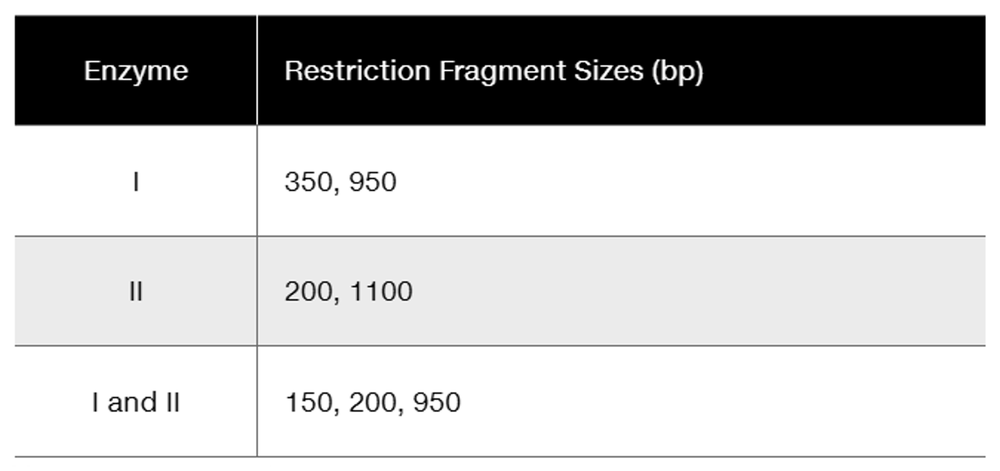If you performed a PCR experiment starting with only one copy of double-stranded DNA, approximately how many DNA molecules would be present in the reaction tube after 15 cycles of amplification?
Table of contents
- 1. Introduction to Genetics51m
- 2. Mendel's Laws of Inheritance3h 37m
- 3. Extensions to Mendelian Inheritance2h 41m
- 4. Genetic Mapping and Linkage2h 28m
- 5. Genetics of Bacteria and Viruses1h 21m
- 6. Chromosomal Variation1h 48m
- 7. DNA and Chromosome Structure56m
- 8. DNA Replication1h 10m
- 9. Mitosis and Meiosis1h 34m
- 10. Transcription1h 0m
- 11. Translation58m
- 12. Gene Regulation in Prokaryotes1h 19m
- 13. Gene Regulation in Eukaryotes44m
- 14. Genetic Control of Development44m
- 15. Genomes and Genomics1h 50m
- 16. Transposable Elements47m
- 17. Mutation, Repair, and Recombination1h 6m
- 18. Molecular Genetic Tools19m
- 19. Cancer Genetics29m
- 20. Quantitative Genetics1h 26m
- 21. Population Genetics50m
- 22. Evolutionary Genetics29m
18. Molecular Genetic Tools
Genetic Cloning
Problem 15
Textbook Question
You have recovered a cloned DNA segment from a vector and determine that the insert is 1300 bp in length. To characterize this cloned segment, you isolate the insert and decide to construct a restriction map. Using enzyme I and enzyme II, followed by gel electrophoresis, you determine the number and size of the fragments produced by enzymes I and II alone and in combination, as recorded in the following table. Construct a restriction map from these data, showing the positions of the restriction-enzyme cutting sites relative to one another and the distance between them in units of base pairs.

 Verified step by step guidance
Verified step by step guidance1
Step 1: Understand the problem. You are tasked with constructing a restriction map for a 1300 bp DNA segment based on the fragment sizes produced by two restriction enzymes (I and II) alone and in combination. A restriction map shows the positions of the cutting sites of the enzymes and the distances between them in base pairs.
Step 2: Analyze the data for enzyme I. When enzyme I is used alone, it produces two fragments of 350 bp and 950 bp. This indicates that enzyme I cuts the DNA at one site, dividing the DNA into two fragments whose sizes add up to the total length of 1300 bp.
Step 3: Analyze the data for enzyme II. When enzyme II is used alone, it produces two fragments of 200 bp and 1100 bp. This indicates that enzyme II cuts the DNA at one site, dividing the DNA into two fragments whose sizes also add up to 1300 bp.
Step 4: Analyze the data for the combination of enzymes I and II. When both enzymes are used together, three fragments are produced: 150 bp, 200 bp, and 950 bp. This suggests that the cutting sites of enzyme I and enzyme II are located at different positions on the DNA, and their combined action creates additional fragments.
Step 5: Construct the restriction map. To do this, determine the relative positions of the cutting sites for enzyme I and enzyme II based on the fragment sizes. Use the data from the combination of enzymes to deduce the distances between the cutting sites. For example, the 150 bp fragment likely represents the distance between the cutting sites of enzyme I and enzyme II, while the 200 bp and 950 bp fragments represent the remaining portions of the DNA after both enzymes have cut.
 Verified video answer for a similar problem:
Verified video answer for a similar problem:This video solution was recommended by our tutors as helpful for the problem above
Video duration:
3mPlay a video:
Was this helpful?
Key Concepts
Here are the essential concepts you must grasp in order to answer the question correctly.
Restriction Enzymes
Restriction enzymes, or restriction endonucleases, are proteins that cut DNA at specific sequences, known as recognition sites. Each enzyme recognizes a unique sequence of nucleotides, allowing for precise cutting of DNA. This property is essential for cloning and DNA manipulation, as it enables researchers to isolate specific DNA fragments for further study or use in genetic engineering.
Recommended video:
Guided course

Mapping with Markers
Gel Electrophoresis
Gel electrophoresis is a laboratory technique used to separate DNA fragments based on their size. When an electric current is applied to a gel matrix, smaller fragments move faster and travel further than larger ones. This method allows researchers to visualize the sizes of DNA fragments produced by restriction enzyme digestion, facilitating the construction of a restriction map.
Recommended video:
Guided course

Proteomics
Restriction Map
A restriction map is a diagram that shows the locations of restriction enzyme cut sites within a DNA segment. It is constructed by analyzing the sizes of DNA fragments generated by different enzymes and their combinations. By comparing the fragment sizes, researchers can infer the relative positions of the cut sites, which is crucial for understanding the structure of the cloned DNA and for planning further experiments.
Recommended video:
Guided course

Mapping with Markers
Related Videos
Related Practice
Textbook Question
631
views


